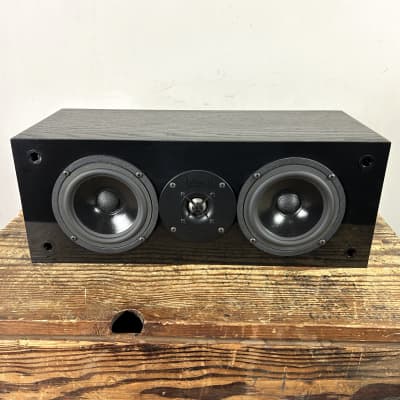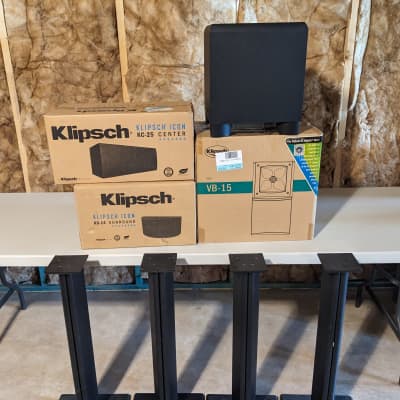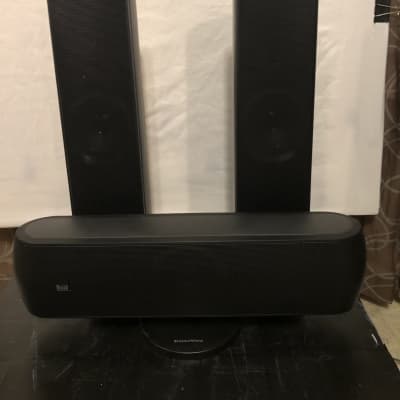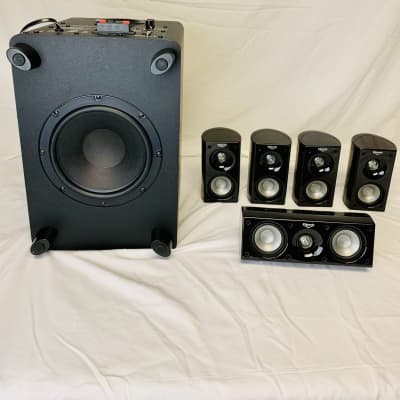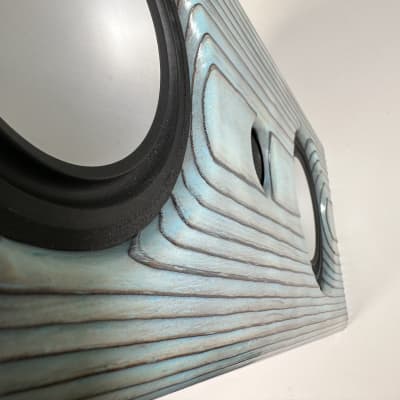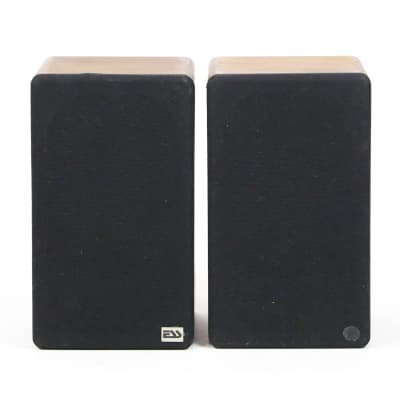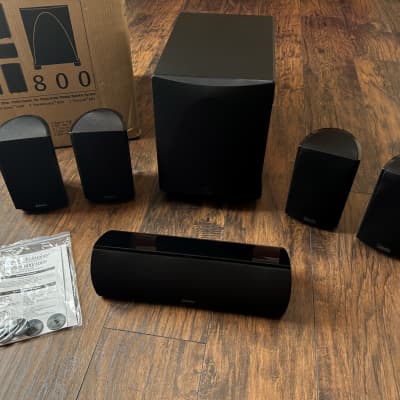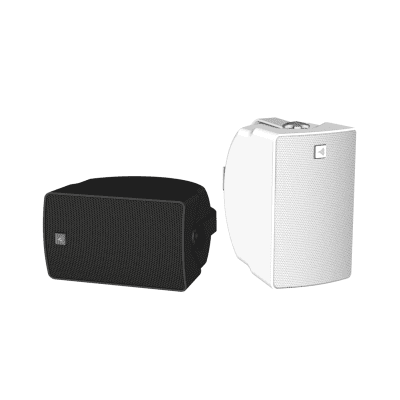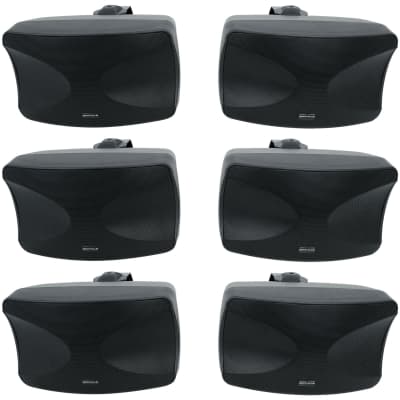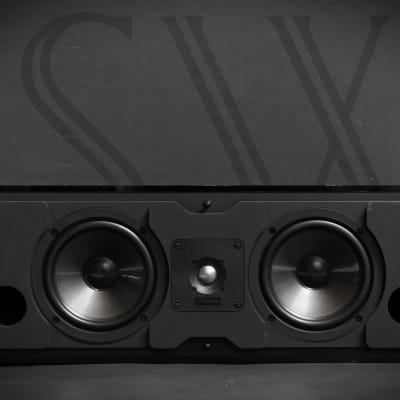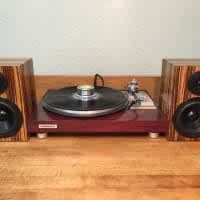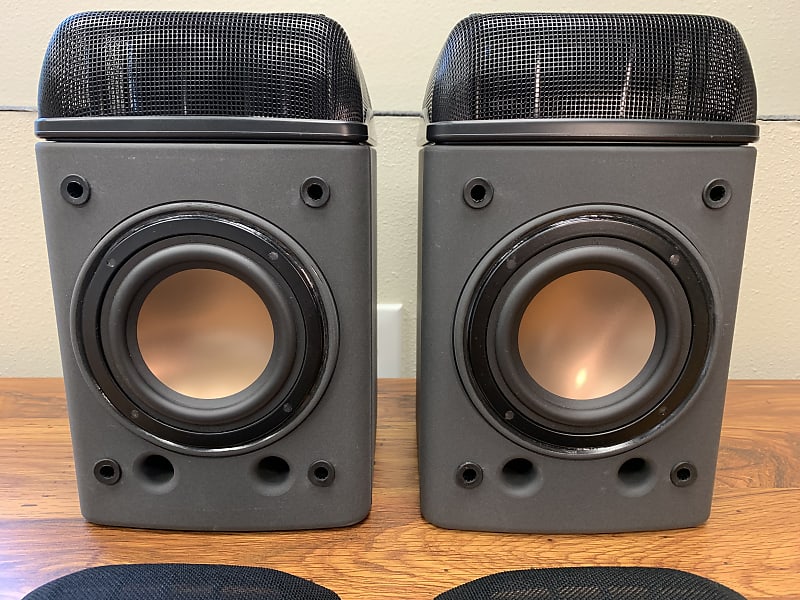

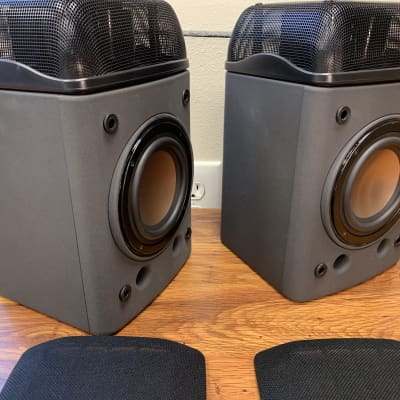
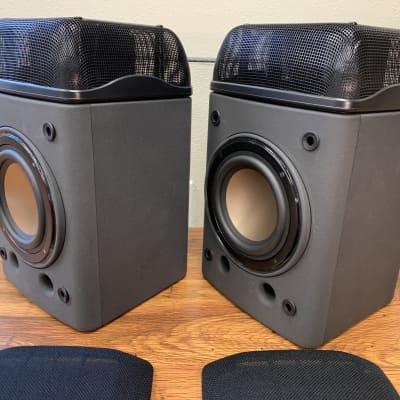
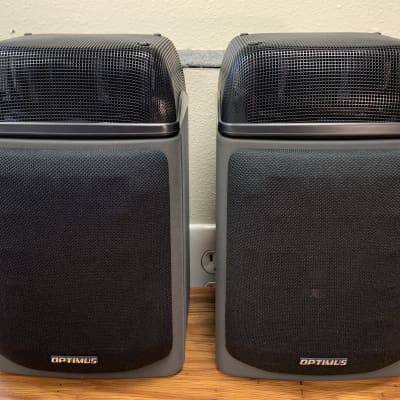
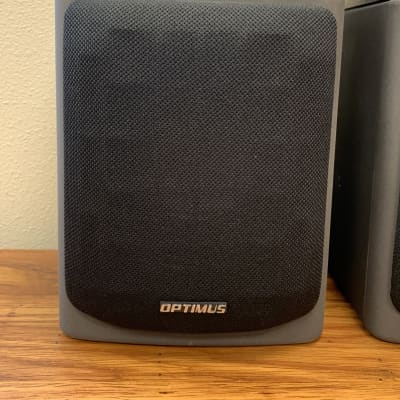
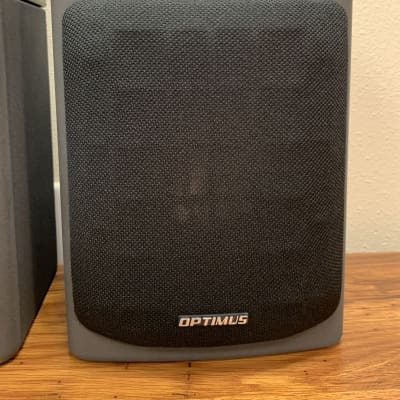
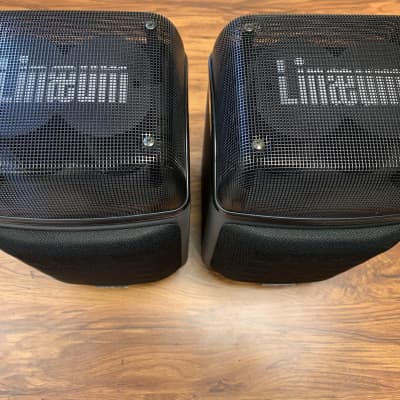
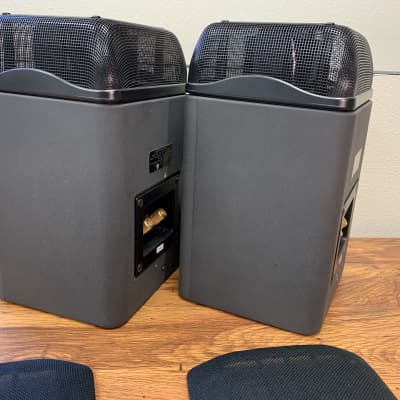
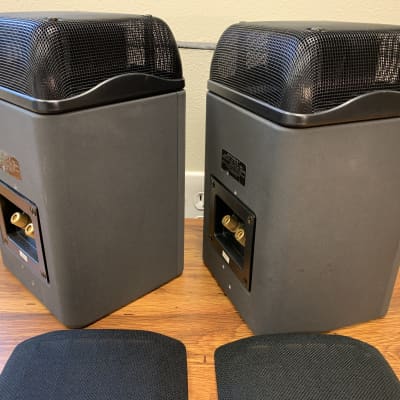
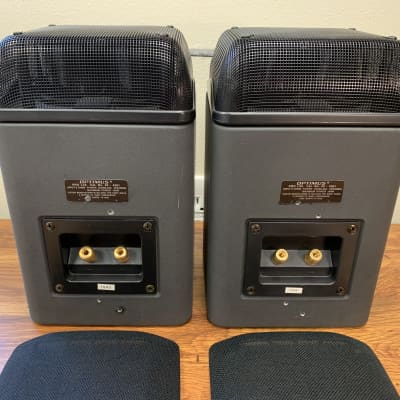
Optimus PRO LX5 with Linæum Tweeters
Here we have the much lauded (and sometimes criticized) Radio Shack/Tandy LX5 with the venerated Linæum tweeter.
They are lauded for the celibrated Linæum dipole tweeter and criticized for the woofer. Indeed, the original woofer is the downfall of this speaker, and I have addressed that with a much needed upgrade. In fact, the criticisms of this speaker all disappear with this upgrade, and these speakers will outshine peers that cost 5-10X more.
The original 5” woofer was actually oversized for the cabinet and port(s) size. I intentionally downsized the woofer with a lovely aluminum bronze-coned 4” beauty. I also packed the speaker with fiber-fill to reduce unwanted resonance. The ports are actually much more functional and less huffy sounding with the 4” driver.
Bass response and power handling are equal to or better than original, despite the small size, because of the upgrade to an aluminum cone from a paper cone, and a butyl rubber suspension in place of the cheap, usually dry-rotted foam surrounds.
Bear in mind, these speakers still can’t defy the laws of physics; if you want really deep bass, you will need a subwoofer.
Gold-plated speaker terminals are a nice touch, they will accommodate bare wire, forked connectors, banana plugs, etc. These speakers are also magnetically shielded.
Frequency response is 60 - 35,000 Hz
Sensitivity is 85dB/1M
Power handling is at least 50W RMS, Continuous - 100W Peak
These speakers are also meticulously cleaned; I took them apart and cleaned the mylar loops of the tweeters by hand! Overall condition is excellent; the die-cast metal frames have some scuffs and scratches here and there. There are some holes in the back that a prior owner used to mount them to a wall; I filled the holes on both sides with epoxy resin.
I have three pairs of these listed, if you wanted to do a 5.1 surround system - which these would rock!
If you want to really nerd it out, I’ve included some vintage write-ups from hi-fi mags!
By Ken Kessler
Senior Contributing Editor, Hi-Fi News & Record Review
Columnist, SoundStage
Technology Columnist, Telegraph Luxury
Optimus PRO LX5 Loudspeaker
Sound & Image and posted in Hi-Fi, Reviews - Loudspeakers
Not once but twice this year the Tandy Corporation has begged from us the question, “What’s going on at Radio Shack?” First, they wow us with a pocket-money CD portable which has the audiophile community in a dither. We sat back, assured that it was a fluke. Not. Now the chain-store giant has released the Optimus PRO LX5 loudspeaker and it’s going to cause another mad rush when people find out just what it is: a Linæum in cheap clothing. Like $300 per pair! And the nearest Linæum equivalent costs double.
Linæum’s claim to fame is a radical tweeter which (we can now say with hindsight) was just begging to be sold under license. And it came to pass that Tandy fitted this brilliant high-frequency unit to a speaker of its own. The Linæum tweeter, unlike a cone or dome, rests on the top surface of the speaker rather than in the baffle. And it radiates in such a way that it begs to be used in home cinema systems where a wide sound spread is so crucial.
It looks more like a home-made transformer surrounded by a couple of loops of cellophane than a tweeter. These “cellophane loops” are Mylar strips which turn out to be the actual diaphragms. Viewed from the top, it reveals itself to be made of centrally-positioned magnets linked by a suspension, beneath an upside-down-U-shaped metal frame. The Mylar sheets are attached to the outer edges of the frame and curve back to meet at the coil between the magnets, thus forming a pair of “cylinders”. The coil is suspended within a balanced magnetic gap under the center of the frame. Signal flows into the coil, interacting with the fields of the magnet assembly, causing coil movement to provide the wave motion through the diaphragm. It’s simple, compact, and effective. Best news of all: it’s able to cover the frequency range from 2kHz to better than 30kHz.
Tandy has matched the Linæum tweeter to a high-compliance 4in bass unit operating from around 90Hz up to 2.5kHz, all housed in a neat 9x6x6in front-ported metal enclosure fitted with gold-plated, multi-way speaker terminals. It’s cute, high-techy in its matt-grey finish, yet all-but-indistinguishable from the myriad nonsensical boom-box add-ons which also wear Mighty Morphin’ Power Rangers clothing. Until you switch it on.
With a dispersion pattern that seems to be nearly all horizontal, the sound radiating in a dipole manner, you can anticipate the need for a reasonable amount of breathing space. As Linæum suggests with its own, similar mini-speaker, ideal positioning calls for 24in stands, three feet from all walls and around 6-7ft in between the speakers. I preferred them with slight toe-in, which creates a “hot seat”, but not so bad as to be deemed anti-social. In the interests of testing for universality, I also tried the PRO LX5s on bookshelves and the damage to the sound was less than I feared. The expected bass reinforcement added weight, but the loss of airiness and three-dimensionality confirms the superiority of stand mounting out in the open.
Tandy doesn’t cite the speaker’s sensitivity, but 50W RMS is the recommended maximum amplifier power rating and an 8 ohm impedance means easy amplifier matching. Which is not to suggest that weedy little A/V receivers will do the trick. I worked the PRO LX5 with some top-flight amplifiers of triple-figure power ratings to learn that this speaker will reveal an amplifier’s shortcomings. Whatever your choice of amplifier make certain that it has lots of clean wattage. Even though horrid little dirt-cheap amplifiers will drive the PRO LX5, it deserves much better.
It’s because Linæum’s tweeter is incredibly revealing even though it’s sweet and smooth. The driver is unforgiving of amplifier clipping but tolerant of hard-edged sources like brighter CD players and most laserdisc and video-tape audio output. It didn’t emphasize the more negative aspects of CD playback, nor did it roll off the sound to eliminate nasties. In effect, the PRO LX5 acts like a serious, full-range product which just happens to be an octave or two short of realism. Which means that this speaker demands to be used with a subwoofer in A/V applications.
At $300 per pair, this speaker is a giveaway: fast, crisp, articulate and musical. Indeed, it’s so inexpensive that you could make a terrific Pro-Logic surround-sound system with three pairs plus any sensible subwoofer, using three PRO LX5s across the front, two at the back and keeping one as a spare. And so surface-covering is the dispersion that I’ll bet a pair at the sides in pseudo-THX manner will work like a dream. And I say that at the risk of incurring the wrath of THX acolyte-nerds.
Whatever way you slice it, the Optimus PRO LX5 is a ridiculously generous bargain. Less refined overall than its dearer Linæum equivalent, true, but still a giveaway.
What is going on at Radio Shack?
(Sound & Image, 1996)
Optimus PRO LX5 Speaker System Review
The Optimus PRO LX5 (sold through Radio Shack stores) is a compact, inexpensive loudspeaker featuring a novel wide-dispersion tweeter that radiates to the front and rear in a dipolar pattern. Designed and manufactured by Linaeum Corporation, the tweeter crosses over at approximately 2.5 kHz to a nominally 5-inch cone woofer operating in a small vented enclosure.
The PRO LX5 enclosure is made of die-cast aluminum with a dark gray, suede-like textured finish. The black grille unsnaps to reveal the woofer cone and two small ports (each about 5/8 inch in diameter). The tweeter, mounted on the top of the speaker, is covered by a perforated metal grille retained by four screws.
The externally visible portion of the Linaeum tweeter consists of two sections of thin plastic about 1-1/2 inches wide, each forming an oval loop extending about 3 inches along the speaker's front-to-back axis. Apparently the loops act as pulsating diaphragms, driven in a manner not readily visible from the outside (even with the perforated grille removed).
It was easy to verify by listening that the tweeter radiated two lobes to the front and rear and had virtually no radiation from the sides - the classic figure-eight pattern characteristic of a dipole radiator. The broad lobes of the pattern provide a wide angle of coverage to front and rear, with the portion of the rear output that is reflected from the wall behind the speaker enhancing the sound's spatiality.
The specifications furnished with the PRO LX5 state that its response extends from 85 Hz to 25 kHz, and a printed "typical" response curve indicates a reasonably uniform output from about 150 Hz to 35 kHz, with a sharp drop at higher frequencies and bass output decreasing at about 10 dB per octave below 150 Hz. The other specifications include a 50-watt power-handling capacity (with a maximum of 100 watts) and a nominal 8-ohm impedance rating.
We tested the Optimus PRO LX5 speakers on 30-inch stands, about 9 feet apart and 18 inches in front of a wall. The room response, averaged for the two speakers and corrected for high-frequency boundary absorption, was notably uniform from about 500 Hz to 20 kHz, with a variation of ±3 dB over that range. The close-miked woofer response closely resembled the printed curve, peaking to a maximum at 150 Hz and falling at 10 dB per octave from there to 20 Hz.
A composite response curve, created by splicing the bass and room-response curves, showed a smooth, flat output over most of the audio range, with a rise at the 20-kHz upper limit of our measurement that gave some credence to the manufacturer's curve. But although the woofer did indeed put out a useful level at 85 Hz, the maximum output at 150 Hz exceeded that level by some 10 dB.
The Linaeum tweeter's horizontal dispersion was excellent, with no significant change in output between on-axis and 45-degree off-axis measurements below 10 kHz and a drop of about 10 dB in the 15-kHz range. But because of the system's unusual radiation pattern at high frequencies, our MLS quasi-anechoic response measurements tended to be more ragged than usual. The multiple reflected outputs from the rear radiation, which tended to smooth out the room measurements, created unavoidable interference patterns in the MLS tests. Group delay (a measure of phase linearity) was unusually low.
The speaker's impedance minimum was about 5 ohms at 70 and 250 Hz, with peaks of 35 ohms at 130 Hz and 20 ohms at 40 Hz and 1.6 kHz. The system sensitivity was 86 dB sound-pressure level (SPL) at 1 meter with an input of 2.83 volts of random noise. We measured the woofer distortion with a 4.2-volt input, equivalent to a 90-dB SPL at 1 meter. Above about 150 Hz the distortion was between 0.6 and 1 percent, but it rose to almost 5 percent at 100 Hz and to 10 percent at 80 Hz.
Despite its small woofer, the Optimus PRO LX5 was able to handle rather large inputs of single-cycle tone bursts without damage. At 100 Hz the woofer cone bottomed with an input of 95 watts, which is quite respectable for a 5-inch driver. At 1 kHz the woofer easily absorbed everything the amplifier could dish out, at 530 watts, and at 10 kHz the Linaeum tweeter had no trouble handling a 1,200-watt input.
The Optimus PRO LX5, despite its low-frequency limitations, produced a surprisingly balanced overall sound, with no obvious lack of bass. Undoubtedly this was because of its very healthy output between 100 and 500 Hz, which gives a good sense of the lower octaves without sounding boomy or unnatural. The speaker's wide, smooth, and well-dispersed middle-and high-frequency output distinguishes it from many others of similar size and price.
In A/B comparisons against other speakers of comparable size, the PRO LX5 easily held its own. When we teamed it with a good subwoofer, the combination was thoroughly satisfying, with the PRO LX5's own low-frequency rolloff nicely complementing the subwoofer's frequency range. Actually, the most interesting aspect of this combination was how little the subwoofer added to the system's sound. Only with programs containing strong, deep bass (under 50 Hz or so) was there any obvious difference in the sound when using the subwoofer.
Here we have the much lauded (and sometimes criticized) Radio Shack/Tandy LX5 with the venerated Linæum tweeter.
They are lauded for the celibrated Linæum dipole tweeter and criticized for the woofer. Indeed, the original woofer is the downfall of this speaker, and I have addressed that with a much needed upgrade. In fact, the criticisms of this speaker all disappear with this upgrade, and these speakers will outshine peers that cost 5-10X more.
The original 5” woofer was actually oversized for the cabinet and port(s) size. I intentionally downsized the woofer with a lovely aluminum bronze-coned 4” beauty. I also packed the speaker with fiber-fill to reduce unwanted resonance. The ports are actually much more functional and less huffy sounding with the 4” driver.
Bass response and power handling are equal to or better than original, despite the small size, because of the upgrade to an aluminum cone from a paper cone, and a butyl rubber suspension in place of the cheap, usually dry-rotted foam surrounds.
Bear in mind, these speakers still can’t defy the laws of physics; if you want really deep bass, you will need a subwoofer.
Gold-plated speaker terminals are a nice touch, they will accommodate bare wire, forked connectors, banana plugs, etc. These speakers are also magnetically shielded.
Frequency response is 60 - 35,000 Hz
Sensitivity is 85dB/1M
Power handling is at least 50W RMS, Continuous - 100W Peak
These speakers are also meticulously cleaned; I took them apart and cleaned the mylar loops of the tweeters by hand! Overall condition is excellent; the die-cast metal frames have some scuffs and scratches here and there. There are some holes in the back that a prior owner used to mount them to a wall; I filled the holes on both sides with epoxy resin.
I have three pairs of these listed, if you wanted to do a 5.1 surround system - which these would rock!
If you want to really nerd it out, I’ve included some vintage write-ups from hi-fi mags!
By Ken Kessler
Senior Contributing Editor, Hi-Fi News & Record Review
Columnist, SoundStage
Technology Columnist, Telegraph Luxury
Optimus PRO LX5 Loudspeaker
Sound & Image and posted in Hi-Fi, Reviews - Loudspeakers
Not once but twice this year the Tandy Corporation has begged from us the question, “What’s going on at Radio Shack?” First, they wow us with a pocket-money CD portable which has the audiophile community in a dither. We sat back, assured that it was a fluke. Not. Now the chain-store giant has released the Optimus PRO LX5 loudspeaker and it’s going to cause another mad rush when people find out just what it is: a Linæum in cheap clothing. Like $300 per pair! And the nearest Linæum equivalent costs double.
Linæum’s claim to fame is a radical tweeter which (we can now say with hindsight) was just begging to be sold under license. And it came to pass that Tandy fitted this brilliant high-frequency unit to a speaker of its own. The Linæum tweeter, unlike a cone or dome, rests on the top surface of the speaker rather than in the baffle. And it radiates in such a way that it begs to be used in home cinema systems where a wide sound spread is so crucial.
It looks more like a home-made transformer surrounded by a couple of loops of cellophane than a tweeter. These “cellophane loops” are Mylar strips which turn out to be the actual diaphragms. Viewed from the top, it reveals itself to be made of centrally-positioned magnets linked by a suspension, beneath an upside-down-U-shaped metal frame. The Mylar sheets are attached to the outer edges of the frame and curve back to meet at the coil between the magnets, thus forming a pair of “cylinders”. The coil is suspended within a balanced magnetic gap under the center of the frame. Signal flows into the coil, interacting with the fields of the magnet assembly, causing coil movement to provide the wave motion through the diaphragm. It’s simple, compact, and effective. Best news of all: it’s able to cover the frequency range from 2kHz to better than 30kHz.
Tandy has matched the Linæum tweeter to a high-compliance 4in bass unit operating from around 90Hz up to 2.5kHz, all housed in a neat 9x6x6in front-ported metal enclosure fitted with gold-plated, multi-way speaker terminals. It’s cute, high-techy in its matt-grey finish, yet all-but-indistinguishable from the myriad nonsensical boom-box add-ons which also wear Mighty Morphin’ Power Rangers clothing. Until you switch it on.
With a dispersion pattern that seems to be nearly all horizontal, the sound radiating in a dipole manner, you can anticipate the need for a reasonable amount of breathing space. As Linæum suggests with its own, similar mini-speaker, ideal positioning calls for 24in stands, three feet from all walls and around 6-7ft in between the speakers. I preferred them with slight toe-in, which creates a “hot seat”, but not so bad as to be deemed anti-social. In the interests of testing for universality, I also tried the PRO LX5s on bookshelves and the damage to the sound was less than I feared. The expected bass reinforcement added weight, but the loss of airiness and three-dimensionality confirms the superiority of stand mounting out in the open.
Tandy doesn’t cite the speaker’s sensitivity, but 50W RMS is the recommended maximum amplifier power rating and an 8 ohm impedance means easy amplifier matching. Which is not to suggest that weedy little A/V receivers will do the trick. I worked the PRO LX5 with some top-flight amplifiers of triple-figure power ratings to learn that this speaker will reveal an amplifier’s shortcomings. Whatever your choice of amplifier make certain that it has lots of clean wattage. Even though horrid little dirt-cheap amplifiers will drive the PRO LX5, it deserves much better.
It’s because Linæum’s tweeter is incredibly revealing even though it’s sweet and smooth. The driver is unforgiving of amplifier clipping but tolerant of hard-edged sources like brighter CD players and most laserdisc and video-tape audio output. It didn’t emphasize the more negative aspects of CD playback, nor did it roll off the sound to eliminate nasties. In effect, the PRO LX5 acts like a serious, full-range product which just happens to be an octave or two short of realism. Which means that this speaker demands to be used with a subwoofer in A/V applications.
At $300 per pair, this speaker is a giveaway: fast, crisp, articulate and musical. Indeed, it’s so inexpensive that you could make a terrific Pro-Logic surround-sound system with three pairs plus any sensible subwoofer, using three PRO LX5s across the front, two at the back and keeping one as a spare. And so surface-covering is the dispersion that I’ll bet a pair at the sides in pseudo-THX manner will work like a dream. And I say that at the risk of incurring the wrath of THX acolyte-nerds.
Whatever way you slice it, the Optimus PRO LX5 is a ridiculously generous bargain. Less refined overall than its dearer Linæum equivalent, true, but still a giveaway.
What is going on at Radio Shack?
(Sound & Image, 1996)
Optimus PRO LX5 Speaker System Review
The Optimus PRO LX5 (sold through Radio Shack stores) is a compact, inexpensive loudspeaker featuring a novel wide-dispersion tweeter that radiates to the front and rear in a dipolar pattern. Designed and manufactured by Linaeum Corporation, the tweeter crosses over at approximately 2.5 kHz to a nominally 5-inch cone woofer operating in a small vented enclosure.
The PRO LX5 enclosure is made of die-cast aluminum with a dark gray, suede-like textured finish. The black grille unsnaps to reveal the woofer cone and two small ports (each about 5/8 inch in diameter). The tweeter, mounted on the top of the speaker, is covered by a perforated metal grille retained by four screws.
The externally visible portion of the Linaeum tweeter consists of two sections of thin plastic about 1-1/2 inches wide, each forming an oval loop extending about 3 inches along the speaker's front-to-back axis. Apparently the loops act as pulsating diaphragms, driven in a manner not readily visible from the outside (even with the perforated grille removed).
It was easy to verify by listening that the tweeter radiated two lobes to the front and rear and had virtually no radiation from the sides - the classic figure-eight pattern characteristic of a dipole radiator. The broad lobes of the pattern provide a wide angle of coverage to front and rear, with the portion of the rear output that is reflected from the wall behind the speaker enhancing the sound's spatiality.
The specifications furnished with the PRO LX5 state that its response extends from 85 Hz to 25 kHz, and a printed "typical" response curve indicates a reasonably uniform output from about 150 Hz to 35 kHz, with a sharp drop at higher frequencies and bass output decreasing at about 10 dB per octave below 150 Hz. The other specifications include a 50-watt power-handling capacity (with a maximum of 100 watts) and a nominal 8-ohm impedance rating.
We tested the Optimus PRO LX5 speakers on 30-inch stands, about 9 feet apart and 18 inches in front of a wall. The room response, averaged for the two speakers and corrected for high-frequency boundary absorption, was notably uniform from about 500 Hz to 20 kHz, with a variation of ±3 dB over that range. The close-miked woofer response closely resembled the printed curve, peaking to a maximum at 150 Hz and falling at 10 dB per octave from there to 20 Hz.
A composite response curve, created by splicing the bass and room-response curves, showed a smooth, flat output over most of the audio range, with a rise at the 20-kHz upper limit of our measurement that gave some credence to the manufacturer's curve. But although the woofer did indeed put out a useful level at 85 Hz, the maximum output at 150 Hz exceeded that level by some 10 dB.
The Linaeum tweeter's horizontal dispersion was excellent, with no significant change in output between on-axis and 45-degree off-axis measurements below 10 kHz and a drop of about 10 dB in the 15-kHz range. But because of the system's unusual radiation pattern at high frequencies, our MLS quasi-anechoic response measurements tended to be more ragged than usual. The multiple reflected outputs from the rear radiation, which tended to smooth out the room measurements, created unavoidable interference patterns in the MLS tests. Group delay (a measure of phase linearity) was unusually low.
The speaker's impedance minimum was about 5 ohms at 70 and 250 Hz, with peaks of 35 ohms at 130 Hz and 20 ohms at 40 Hz and 1.6 kHz. The system sensitivity was 86 dB sound-pressure level (SPL) at 1 meter with an input of 2.83 volts of random noise. We measured the woofer distortion with a 4.2-volt input, equivalent to a 90-dB SPL at 1 meter. Above about 150 Hz the distortion was between 0.6 and 1 percent, but it rose to almost 5 percent at 100 Hz and to 10 percent at 80 Hz.
Despite its small woofer, the Optimus PRO LX5 was able to handle rather large inputs of single-cycle tone bursts without damage. At 100 Hz the woofer cone bottomed with an input of 95 watts, which is quite respectable for a 5-inch driver. At 1 kHz the woofer easily absorbed everything the amplifier could dish out, at 530 watts, and at 10 kHz the Linaeum tweeter had no trouble handling a 1,200-watt input.
The Optimus PRO LX5, despite its low-frequency limitations, produced a surprisingly balanced overall sound, with no obvious lack of bass. Undoubtedly this was because of its very healthy output between 100 and 500 Hz, which gives a good sense of the lower octaves without sounding boomy or unnatural. The speaker's wide, smooth, and well-dispersed middle-and high-frequency output distinguishes it from many others of similar size and price.
In A/B comparisons against other speakers of comparable size, the PRO LX5 easily held its own. When we teamed it with a good subwoofer, the combination was thoroughly satisfying, with the PRO LX5's own low-frequency rolloff nicely complementing the subwoofer's frequency range. Actually, the most interesting aspect of this combination was how little the subwoofer added to the system's sound. Only with programs containing strong, deep bass (under 50 Hz or so) was there any obvious difference in the sound when using the subwoofer.
Reverb Buyer Protection
Reverb has your back if your item is lost, damaged, or doesn't match its description. Simply report any issues within 7 days and we'll help you get a full refund.Learn more about Reverb Buyer Protection.
| Listed | 2 years ago |
| Condition | Very Good (Used) Very Good items may show a few slight marks or scratches but are fully functional and in overall great shape.Learn more |
| Brand | |
| Model |
|
| Finish |
|
| Categories | |
| Year |
|
| Made In |
|
